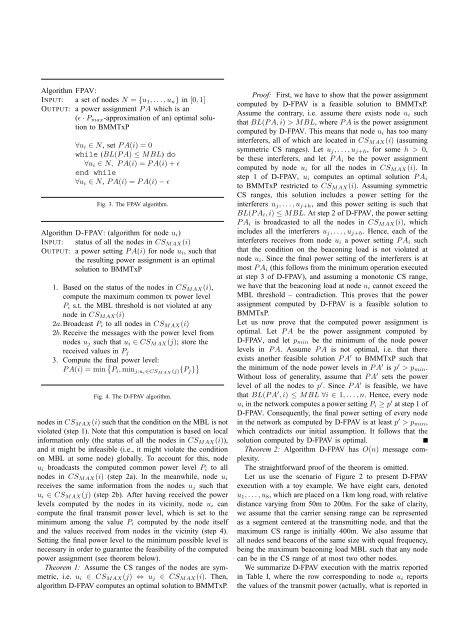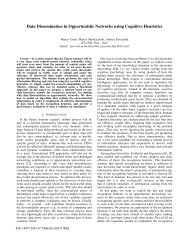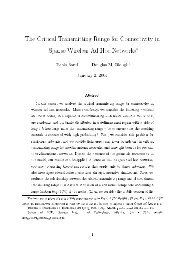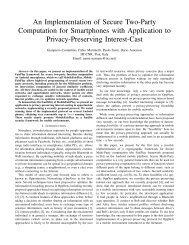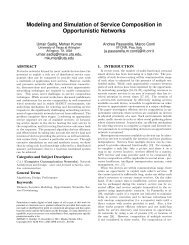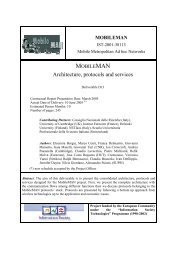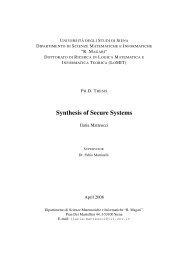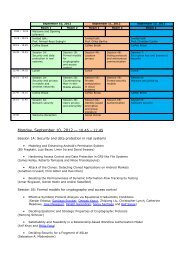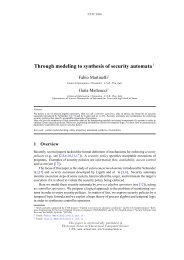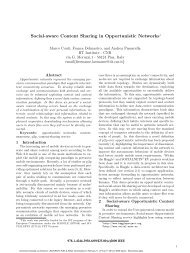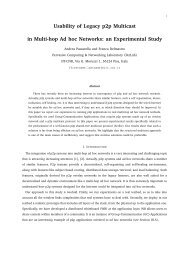Distributed Fair Transmit Power Adjustment for Vehicular Ad Hoc ...
Distributed Fair Transmit Power Adjustment for Vehicular Ad Hoc ...
Distributed Fair Transmit Power Adjustment for Vehicular Ad Hoc ...
You also want an ePaper? Increase the reach of your titles
YUMPU automatically turns print PDFs into web optimized ePapers that Google loves.
Algorithm FPAV:INPUT: a set of nodes N = {u 1 ,...,u n } in [0,1]OUTPUT: a power assignment PA which is an(ǫ · P max -approximation of an) optimal solutionto BMMTxP∀u i ∈ N, set PA(i) = 0while (BL(PA) ≤ MBL) do∀u i ∈ N, PA(i) = PA(i) + ǫend while∀u i ∈ N, PA(i) = PA(i) − ǫFig. 3. The FPAV algorithm.Algorithm D-FPAV: (algorithm <strong>for</strong> node u i )INPUT: status of all the nodes in CS MAX (i)OUTPUT: a power setting PA(i) <strong>for</strong> node u i , such thatthe resulting power assignment is an optimalsolution to BMMTxP1. Based on the status of the nodes in CS MAX (i),compute the maximum common tx power levelP i s.t. the MBL threshold is not violated at anynode in CS MAX (i)2a.Broadcast P i to all nodes in CS MAX (i)2b. Receive the messages with the power level fromnodes u j such that u i ∈ CS MAX (j); store thereceived values in P j3. Compute the final power level:PA(i) = min { P i ,min j:ui∈CS MAX(j){P j } }Fig. 4. The D-FPAV algorithm.nodes in CS MAX (i) such that the condition on the MBL is notviolated (step 1). Note that this computation is based on localin<strong>for</strong>mation only (the status of all the nodes in CS MAX (i)),and it might be infeasible (i.e., it might violate the conditionon MBL at some node) globally. To account <strong>for</strong> this, nodeu i broadcasts the computed common power level P i to allnodes in CS MAX (i) (step 2a). In the meanwhile, node u ireceives the same in<strong>for</strong>mation from the nodes u j such thatu i ∈ CS MAX (j) (step 2b). After having received the powerlevels computed by the nodes in its vicinity, node u i cancompute the final transmit power level, which is set to theminimum among the value P i computed by the node itselfand the values received from nodes in the vicinity (step 4).Setting the final power level to the minimum possible level isnecessary in order to guarantee the feasibility of the computedpower assignment (see theorem below).Theorem 1: Assume the CS ranges of the nodes are symmetric,i.e. u i ∈ CS MAX (j) ⇔ u j ∈ CS MAX (i). Then,algorithm D-FPAV computes an optimal solution to BMMTxP.Proof: First, we have to show that the power assignmentcomputed by D-FPAV is a feasible solution to BMMTxP.Assume the contrary, i.e. assume there exists node u i suchthat BL(PA,i) > MBL, where PA is the power assignmentcomputed by D-FPAV. This means that node u i has too manyinterferers, all of which are located in CS MAX (i) (assumingsymmetric CS ranges). Let u j ,...,u j+h , <strong>for</strong> some h > 0,be these interferers, and let PA i be the power assignmentcomputed by node u i <strong>for</strong> all the nodes in CS MAX (i). Instep 1 of D-FPAV, u i computes an optimal solution PA ito BMMTxP restricted to CS MAX (i). Assuming symmetricCS ranges, this solution includes a power setting <strong>for</strong> theinterferers u j ,...,u j+h , and this power setting is such thatBL(PA i ,i) ≤ MBL. At step 2 of D-FPAV, the power settingPA i is broadcasted to all the nodes in CS MAX (i), whichincludes all the interferers u j ,...,u j+h . Hence, each of theinterferers receives from node u i a power setting PA i suchthat the condition on the beaconing load is not violated atnode u i . Since the final power setting of the interferers is atmost PA i (this follows from the minimum operation executedat step 3 of D-FPAV), and assuming a monotonic CS range,we have that the beaconing load at node u i cannot exceed theMBL threshold – contradiction. This proves that the powerassignment computed by D-FPAV is a feasible solution toBMMTxP.Let us now prove that the computed power assignment isoptimal. Let PA be the power assignment computed byD-FPAV, and let p min be the minimum of the node powerlevels in PA. Assume PA is not optimal, i.e. that thereexists another feasible solution PA ′ to BMMTxP such thatthe minimum of the node power levels in PA ′ is p ′ > p min .Without loss of generality, assume that PA ′ sets the powerlevel of all the nodes to p ′ . Since PA ′ is feasible, we havethat BL(PA ′ ,i) ≤ MBL ∀i ∈ 1,...,n. Hence, every nodeu i in the network computes a power setting P i ≥ p ′ at step 1 ofD-FPAV. Consequently, the final power setting of every nodein the network as computed by D-FPAV is at least p ′ > p min ,which contradicts our initial assumption. It follows that thesolution computed by D-FPAV is optimal.Theorem 2: Algorithm D-FPAV has O(n) message complexity.The straight<strong>for</strong>ward proof of the theorem is omitted.Let us use the scenario of Figure 2 to present D-FPAVexecution with a toy example. We have eight cars, denotedu 1 ,...,u 8 , which are placed on a 1km long road, with relativedistance varying from 50m to 200m. For the sake of clarity,we assume that the carrier sensing range can be representedas a segment centered at the transmitting node, and that themaximum CS range is initially 400m. We also assume thatall nodes send beacons of the same size with equal frequency,being the maximum beaconing load MBL such that any nodecan be in the CS range of at most two other nodes.We summarize D-FPAV execution with the matrix reportedin Table I, where the row corresponding to node u i reportsthe values of the transmit power (actually, what is reported in


